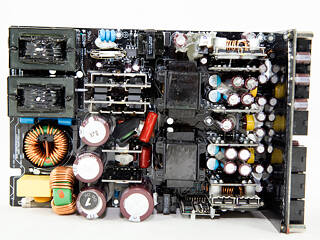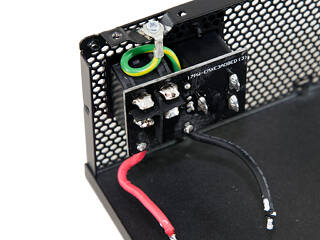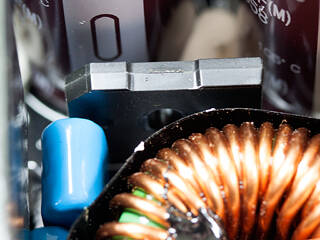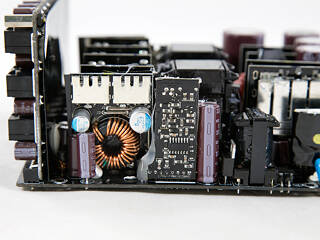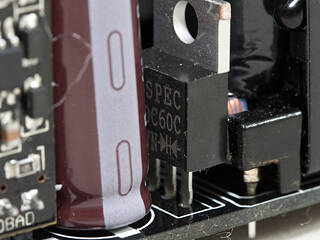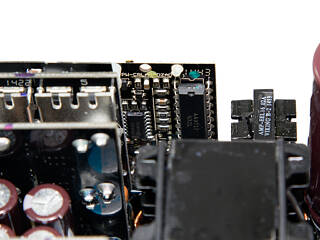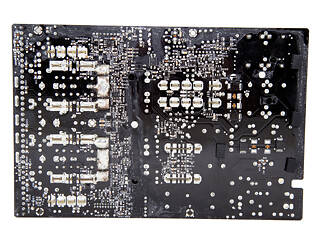 23
23
Super Flower Leadex Platinum 2000 W Review
Load Regulation, Hold-up Time & Inrush Current »A Look Inside & Component Analysis
Before reading this page, we strongly suggest a look at this article, which will help you understand the internal components of a PSU much better. Our main tool for the disassembly of the PSU is a Thermaltronics TMT-9000S soldering and rework station. It is of extreme quality and is equipped with a matching de-soldering gun. With such equipment in hand, breaking apart every PSU is like a walk in the park!| Super Flower SF-2000F14HP Parts Description | |
|---|---|
| Primary Side | |
| Transient Filter | 6x Y caps, 2x X caps, 2x CM chokes, 1x MOV |
| Bridge Rectifier(s) | Bridgeless Design - 1x US30K80RΒ & 8x Infineon MOSFETs |
| Inrush Current Protection | NTC Thermistor & Relay |
| APFC Mosfets | 8x Infineon MOSFETs |
| APFC Boost Diode | 4x CREE C3D08060G |
| Hold-up Cap(s) | 4x Nippon Chemi-Con (400 V, 3x 390 uF & 1x 470 uF; 1640 uF combined, 105°C, KMW) |
| Main Switchers | 4x IPP60R099CP |
| APFC Controller | SF29603 |
| Switching Controller | SFAA9013 |
| Topology | Primary side: Bridgeless PFC & Full-Bridge LLC & Resonant Converter Secondary side: Synchronous Rectification & DC-DC converters |
| Secondary Side | |
| +12V | 16x Infineon BSC027N04LS |
| 5V & 3.3V | DC-DC Converters: 8x Infineon IPD060N03Β fets |
| Filtering Capacitors | Electrolytics: Chemi-Con, 105 °C, KY & KRG Polymers: Chemi-Con |
| Supervisor IC | AA9013 (probably) & LM324ADG |
| Fan Model | Globe Fan RL4Z-B1402512EH (140 mm, 12 V, 0.6 A, 2000 RPM, 153.47 CFM, 39.5 dB(A), 70,000-hour MTBF) |
| 5VSB Circuit | |
| Rectifying Diode | Mospec S10C60C |
| Standby PWM Controller | 29604 |
This platform is the same as in Super Flower's 1.6 kW Leadex Titanium PSU or the similarly strong EVGA G2 and P2 units. Its cutting-edge design not only enables it to achieve such a high capacity as it is also incredibly efficienct. Super Flower says the unit to meet 80 Plus Platinum requirements with 230 VAC input (92% efficiency with 20% load, 94% with 50% load, and 90% at full load). With the SF-2000F14HP, AC rectification takes part inside the APFC converter instead of separate bridge rectifiers, which leads to a significant efficiency boost. The primary side also uses a full-bridge topology, while the secondary side makes use of a synchronous design with a huge number of fets that handle the +12V rail. As expected, DC-DC converters generate the minor rails. In short, the unit uses a bridgeless PFC and a full-bridge topology with an LLC resonant converter, with a synchronous design and DC-DC converters in the secondary side.
Behind the AC receptacle is a small PCB that doesn't include any of the transient filer's components. The latter are installed on the main PCB and include three pairs of Y caps, a pair of X caps, an MOV, and two CM chokes, which also completes the transient filter.
Here is a single bridge rectifier, a US30K80R. It is only put to use at very light loads or in standby mode.
The APFC converter consists of two fully packed daughter-boards and two large coils. Each of the boards holds eight fets that are protected against EMI by metal shields and four CREE C3D08060G boost diodes. These boards not only bring the power factor close to unity, but also fully rectify the incoming alternating current (AC) voltage. Four parallel Nippon Chemi-Cons are used as bulk caps (400 V, 3x 390 uF & 1x 470 uF or 1640 uF combined, 105°C, KMW), and we suspect that their capacity isn't enough to keep this PSU's maximum power output for at least 16 ms once the mains power is removed.
The PFC controller, a proprietary IC codenamed SF29603, is on this EMI shielded board.
A pretty large NTC thermistor protects the unit against large inrush currents, and it has its own relay to cut it off the circuit as required.
Two boards hold all the main switchers, four Infineon IPP60R099CPs arranged into a full-bridge topology. An LLC converter is also used to boost efficiency.
Four vertical PCBs in the secondary side house all the mosfets that regulate the +12V rail. In total, 16 Infineon BSC027N04LS fets have been assigned to the task, and our tests prove that they can provide much more than 2 kW should the need arise.
Two DC-DC converters handle the minor rails. Each converter uses four Infineon IPD060N03 fets. Right next to one of these boards is the PCB that houses the fan's control circuit and a Mospec S10C60C SBR that generates the 5VSB rail. The same PCB also houses an LM324ADG.
The standby PWM controller has "29604" written on it, which didn't prove terribly useful in identifying it.
All filtering capacitors in the secondary side, electrolytic and polymer, are by Nippon Chemi-Con, so they are of very high quality.
On the other side of the daughter-board depicted above is the resonant controller, an AA9013 IC for which there is no available information. There is also a LM324ADG IC on the same board.
On the primary side of the modular PCB are a large number of polymer and electrolytic caps. These caps are used for ripple-filtering purposes. All are provided by Chemi-Con, so there is no doubt about their high quality.
Soldering quality isn't the best we have seen from Super Flower. The manufacturing line probably needs some tuning. We didn't like the finish on the PCB's solder side, and there were also some sloppy solder jobs that could have been avoided. However, our tests show that the soldering quality doesn't seem to affect performance.
The cooling fan is the same as in all high-end Super Flower units. It is by Globe Fan, and its model number is RL4Z-B1402512EH (140 mm, 12 V, 0.6 A, 2000 RPM, 153.47 CFM, 39.5 dBA, 70.000 MTBF). This fan is equipped with double ball-bearings for increased longevity, and the fan's profile isn't what we would call relaxed, which comes as no surprise since this PSU is a real power house. The PSU also doesn't feature a semi-passive mode, but contrary to other SF implementations, its fan-control circuit comes with many speed profiles that will, depending on ambient conditions, vary fan speed a lot as there are more than three or four available modes it switches between.
Apr 26th, 2024 18:26 EDT
change timezone
Latest GPU Drivers
New Forum Posts
- Best SSD for system drive (96)
- What phone you use as your daily driver? And, a discussion of them. (1492)
- AMD Radeon™ R9 390X (GV-R939XG1) (0)
- TPU's Nostalgic Hardware Club (18475)
- looking to build a new system and im considering asrock brand but i have some doubts/concerns. (6)
- What's your latest tech purchase? (20354)
- 5800x (and other Zen 3 chips) PBO settings/Temperature fix (934)
- Only EDP Other in Core? (2)
- Alphacool CORE 1 CPU block - bulging with danger of splitting? (30)
- Dell Workstation Owners Club (3061)
Popular Reviews
- HYTE THICC Q60 240 mm AIO Review
- MOONDROP x Crinacle DUSK In-Ear Monitors Review - The Last 5%
- Upcoming Hardware Launches 2023 (Updated Feb 2024)
- Alienware Pro Wireless Gaming Keyboard Review
- Thermalright Phantom Spirit 120 EVO Review
- Ugreen NASync DXP4800 Plus Review
- FiiO K19 Desktop DAC/Headphone Amplifier Review
- ASUS Radeon RX 7900 GRE TUF OC Review
- AMD Ryzen 7 7800X3D Review - The Best Gaming CPU
- Sapphire Radeon RX 7900 GRE Pulse Review
Controversial News Posts
- Windows 11 Now Officially Adware as Microsoft Embeds Ads in the Start Menu (135)
- Sony PlayStation 5 Pro Specifications Confirmed, Console Arrives Before Holidays (117)
- NVIDIA Points Intel Raptor Lake CPU Users to Get Help from Intel Amid System Instability Issues (106)
- AMD "Strix Halo" Zen 5 Mobile Processor Pictured: Chiplet-based, Uses 256-bit LPDDR5X (103)
- US Government Wants Nuclear Plants to Offload AI Data Center Expansion (98)
- AMD's RDNA 4 GPUs Could Stick with 18 Gbps GDDR6 Memory (95)
- Developers of Outpost Infinity Siege Recommend Underclocking i9-13900K and i9-14900K for Stability on Machines with RTX 4090 (85)
- Windows 10 Security Updates to Cost $61 After 2025, $427 by 2028 (84)

